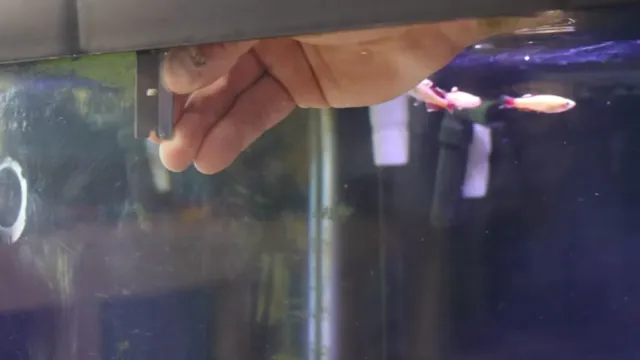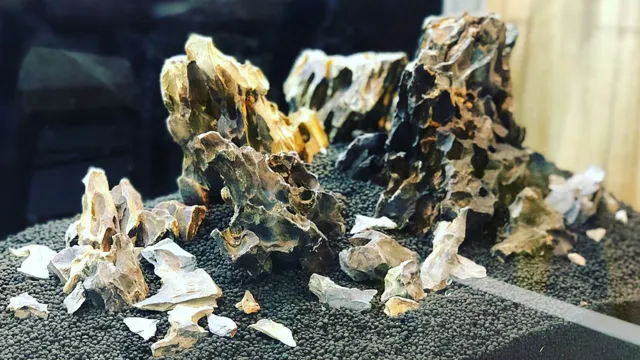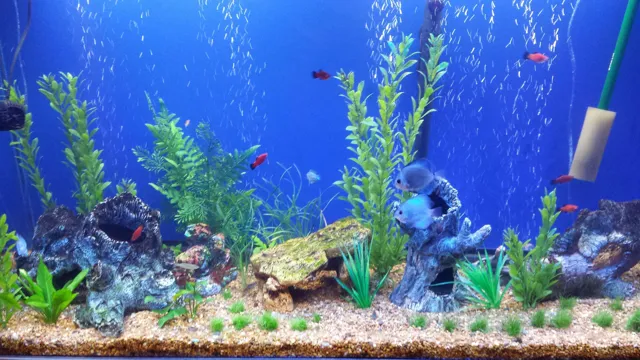How to Clean Mineral Film off of Aquarium Glass: Expert Tips for a Sparkling Clear Fish Tank

If you are an aquarium owner, then you know the struggle of keeping your aquarium clean and clear. One of the most frustrating things that can happen is a buildup of mineral film on the glass. Not only does it ruin the aesthetic of your aquarium, but it can also affect the health of your aquatic pets.
So, how do you remove this mineral film from your aquarium glass? Firstly, it’s important to identify what’s causing the mineral buildup in your aquarium. Tap water is often the culprit, containing high levels of minerals such as calcium and magnesium. These minerals can form deposits on the glass over time.
Thankfully, there are several methods to remove mineral film from aquarium glass. You can use a commercial aquarium glass cleaner, which is specifically designed to dissolve mineral buildup without harming your aquatic pets. Another option is to mix vinegar and water in equal parts and apply it to the glass with a soft cloth.
Let it sit for a few minutes before wiping it away. It’s important to only use gentle, non-abrasive methods to clean your aquarium glass, as harsh chemicals and cleaners can be harmful to your aquatic pets. Always do a water change after cleaning to ensure that all traces of the cleaner are removed from the tank.
In conclusion, removing mineral film from aquarium glass may seem like a daunting task, but it’s actually quite simple with the right methods. By identifying the cause of the mineral buildup and using gentle, non-abrasive cleaning methods, you can keep your aquarium glass clear and your aquatic pets healthy and happy.
What Causes Mineral Film in Aquariums?
If you’re an aquarium owner, you might have noticed a mineral film buildup on the glass walls over time. This film can be a result of several factors, including minerals in the tap water, fish waste and food particles, and even the aquarium decorations. To get rid of mineral film, you can try using a razor blade to scrape it off gently.
However, be careful not to scratch the glass in the process. Using an aquarium-safe glass cleaner can also be effective in removing the film. It’s important to regularly clean your aquarium to prevent the buildup of mineral film, which can obscure the view and harm your aquatic pets.
By changing the water often and cleaning the glass, you can ensure a healthy and clear environment for your fish to thrive in.
Hard Water vs. Soft Water
Aquariums can be a beautiful addition to any home or office, but one issue that many aquarium owners face is the build-up of mineral film on the glass. This film can be caused by hard water, which contains high levels of minerals like calcium and magnesium. When the water evaporates, these minerals are left behind, creating a stubborn residue on the glass.
Soft water, on the other hand, contains fewer minerals and is less likely to leave behind this type of film. One way to prevent mineral film in aquariums is to use a water softener to reduce the level of minerals in the water. Alternatively, frequent cleaning of the glass with a specialized aquarium cleaner can also help.
By taking steps to prevent mineral film, you can keep your aquarium looking its best and ensure that your fish and other aquatic life are healthy and happy.

Evaporation and Dissolved Minerals
Mineral film in aquariums can be caused by several factors, including evaporation and dissolved minerals. When water evaporates, it leaves behind any minerals and other substances that were dissolved in it, creating a build-up of mineral deposits on surfaces. In an aquarium, this process can lead to the formation of unsightly white film on the glass walls, substrate, and decorations.
The mineral content of the water can also contribute to the formation of such deposits. High levels of calcium, magnesium, and other minerals can cause the water to have a high hardness level, which increases the risk of mineral build-up. Regular water changes and the use of a good filtration system can help reduce the levels of dissolved minerals and lessen the occurrence of mineral film.
Additionally, using a water softener or a reverse osmosis system can help ensure that the water used in the aquarium is free from excess minerals that can cause unsightly film buildup.
How Mineral Film Affects Your Aquarium
Mineral film is a common issue encountered by aquarium owners, and it can occur due to a variety of factors. The main culprit behind mineral film is the buildup of minerals and other substances in the water, including calcium, magnesium, and other metallic compounds. These minerals can accumulate on the surface of aquarium glass and other surfaces, forming a thin film that can be unsightly and even harmful to aquatic life.
Some of the primary causes of mineral film in aquariums include tap water that is high in minerals, overfeeding fish, and poor filtration or water circulation. To combat mineral film, it is essential to maintain regular cleaning and maintenance of the aquarium, using tools and products specifically designed to break down and remove mineral buildup. Additionally, reducing the amount of fish food added to the aquarium can help prevent excess minerals from accumulating in the water, as can using a high-quality filtration system that can effectively remove mineral deposits from the water.
By taking these steps, aquarium owners can keep their fish and aquatic life healthy and thriving, while also maintaining a clean and visually appealing environment.
Removing Mineral Film from Aquarium Glass
If you’re the owner of an aquarium, you may have noticed a cloudy white film forming on the glass. This is mineral film, a build-up of calcium and other minerals in the water. Not only does it decrease the visibility of your fish, plants, and decorations, but it also makes your aquarium look dirty.
Fortunately, there are a few simple ways to remove mineral film from aquarium glass. One way is to use a mixture of vinegar and water in a spray bottle and spray it onto the glass. Let it sit for a few minutes, then wipe it away with a clean cloth.
Another method is to use a scraper to gently scrape off the film, being careful not to scratch the glass. Regardless of the method you choose, it’s important to keep up with regular maintenance to prevent the build-up of mineral film in the future. By keeping your aquarium glass clean and clear, you’ll be able to enjoy the beauty of your aquatic world.
Step 1: Empty the Tank
If you’re dealing with mineral buildup on your aquarium glass, the first step to removing it is to empty the tank. This is important because it allows you to get a clear view of the glass and see exactly where the mineral film has formed. To do this, you’ll need to carefully transfer your fish and other aquatic inhabitants to a temporary holding tank.
It’s important to make sure the holding tank has the same temperature and water chemistry as the main tank to minimize stress on your fish. Once the tank is empty, you can examine the glass for mineral buildup. This buildup is typically caused by hard water in the aquarium, and can be difficult to remove if left unchecked.
But don’t worry – with the right techniques, you can get your glass looking crystal clear in no time. Using a razor blade or scraper, gently remove the buildup from the glass, being careful not to scratch the surface. With a little patience and elbow grease, you’ll have your aquarium looking brand new again.
Step 2: Scrub with a Glass Scraper
When it comes to maintaining a clean aquarium, removing mineral film from the glass is an essential step. One effective way to do this is by using a glass scraper. This tool can effectively remove stubborn mineral buildup and algae from the glass surface without damaging it.
To use a glass scraper, simply begin at one corner of the aquarium and gently glide the scraper along the glass surface in a straight line. It’s essential to use a gentle and steady hand to avoid scratching the glass. If the mineral buildup is particularly stubborn, you can soak the affected area in vinegar for a few minutes before using the scraper.
Be sure to rinse the glass thoroughly after using the scraper to remove any remaining debris. With regular maintenance, your aquarium glass will remain crystal clear and free from unsightly mineral film.
Step 3: Use a Cleaning Solution
When dealing with a mineral film buildup on your aquarium glass, you’ll want to use a cleaning solution to effectively remove it. There are a few options to consider, but one of the most effective is a mixture of vinegar and water. Simply mix equal parts of white vinegar and water in a spray bottle and mist the affected areas.
Let it sit for a few minutes before wiping it away with a clean cloth or paper towel. Another option is to use a specialized aquarium glass cleaner, which can be purchased at most pet stores. Follow the instructions carefully and make sure to rinse the glass thoroughly afterward to prevent any residue from harming your aquatic pets.
Remember to avoid using any abrasive cleaners or tools, as they can scratch or damage the glass and harm your fish and plants. By using a gentle yet effective cleaning solution and taking the necessary precautions, you can easily remove any unsightly mineral buildup from your aquarium glass.
Step 4: Rinse and Dry
To ensure a clean and clear aquarium, the final step is to rinse and dry the glass. Use a clean, soft cloth or sponge to rinse off any remaining solution or residue. Be sure to rinse thoroughly to avoid leaving behind any traces of the cleaning solution.
Afterward, use a dry cloth to wipe down the glass and remove any excess water. It is important to dry the glass completely to prevent any water spots or streaks from appearing. Air drying is another option, but it may take longer to achieve a streak-free finish.
With proper rinsing and drying techniques, your aquarium glass will be free from any mineral film and ready for your fish and plants to enjoy.
Preventing Mineral Film in Your Aquarium
If you’re an aquarium owner, you’ve probably encountered mineral film on your tank’s glass at some point. This unsightly layer can accumulate on the glass due to minerals in the water, which can be a pain to clean off. Luckily, there are a few things you can do to prevent it from forming in the first place.
Firstly, make sure you’re using a high-quality aquarium water conditioner to remove heavy metals and other impurities from tap water. You can also consider using a RO/DI unit to purify your water before adding it to the tank. Regular water changes can help keep mineral levels down, as can using a surface skimmer to remove any buildup on the water’s surface.
Additionally, you can try running a filter with activated carbon to remove impurities and keep your tank’s water clean and clear. By taking these preventative measures, you can keep your aquarium looking crystal clear and free of mineral film.
Maintain Consistent Water Quality
Maintaining consistent water quality is of utmost importance in keeping your aquarium healthy and thriving. One common problem among aquarium owners is the buildup of mineral film on the glass and other surfaces. This unsightly and potentially harmful film can develop due to a variety of factors, including high levels of minerals or alkalinity in the water, overfeeding, and inadequate filtration.
To prevent mineral film buildup, it’s essential to test your water regularly and make adjustments as needed to maintain proper mineral levels. Additionally, ensure that you’re not overfeeding your fish, as excess food can contribute to the buildup of mineral film. Finally, invest in an effective filtration system to help keep your water clean and clear.
By taking these steps, you can prevent mineral film buildup and maintain a healthy, vibrant aquarium environment.
Use a Water Softener or Filter
If you are an aquarium enthusiast, you know how important it is to maintain the health of your aquatic pets. One major issue that many aquarium owners face is the buildup of mineral film in their tanks. This can be prevented by installing a water softener or filter in your home.
A water softener works by removing the minerals that cause hardness in your tap water, preventing the mineral film from forming in your aquarium. A filter can also be used to remove the minerals, as well as other impurities, from your water. By investing in a water softener or filter, you can ensure that your aquarium remains a healthy and safe environment for your fish and other aquatic pets.
So, why not take this simple step to prevent mineral buildup and maintain the beauty of your underwater world?
Regular Water Changes
Regular water changes are crucial for keeping an aquarium free from mineral film buildup. Over time, minerals found in tap water can accumulate and form a layer of unsightly film on the aquarium glass and any ornaments inside. By performing regular water changes, you can help prevent this buildup and ensure your aquarium remains clean and healthy for your fish.
It’s recommended to change roughly 10-15% of the water in your aquarium every week to help dilute any excess minerals and keep the water chemistry stable. Additionally, using a water conditioner can help neutralize any harmful chemicals present in your tap water, further promoting a healthy environment for your fish. So, if you want to keep your aquarium looking beautiful and your fish happy, don’t forget the importance of regular water changes.
Avoid Overcrowding and Overfeeding
Preventing Mineral Film in Your Aquarium by Avoiding Overcrowding and Overfeeding When it comes to maintaining a healthy and visually appealing aquarium, preventing mineral film is of utmost importance. This pesky buildup of minerals, algae, and other organic matter can form on the glass surface of your tank, leading to unsightly obstructions that make it difficult to enjoy the view. Two common culprits for mineral film formation are overcrowding and overfeeding.
When too many fish are crammed into a small space, they generate excess waste that can contribute to the buildup of organic matter. Similarly, when you provide your fish with more food than they can consume, the leftovers settle onto the glass and provide fodder for mineral film growth. By avoiding these two practices, you can drastically reduce the likelihood of mineral film development in your aquarium.
So, be mindful of how many fish you have, and only feed what your fish can finish in a single sitting. By taking these simple steps, you can keep your tank looking beautiful and healthy for both your fish and yourself to enjoy.
Conclusion
In conclusion, cleaning mineral film off of aquarium glass may seem like a daunting task, but with the right approach, it can be easily conquered. Just remember to use distilled white vinegar and a good old-fashioned elbow grease to banish those unsightly deposits. And if all else fails, just tell your fish to embrace the natural, rugged look of their new mineral-encrusted home.
After all, who needs shiny clean glass when you have a pet underwater rock garden?”
FAQs
What causes mineral film to form on aquarium glass?
Mineral film on aquarium glass is a result of hard water evaporating and leaving behind mineral deposits.
What are some natural ways to clean mineral film off of aquarium glass?
One natural way to clean mineral film off of aquarium glass is to use a vinegar-water solution. Another option is to use a lemon and baking soda mixture.
Can harsh chemicals be used to clean mineral film off of aquarium glass?
It’s best to avoid using harsh chemicals to clean aquarium glass as it can harm the fish and plants living inside.
How often should aquarium glass be cleaned to prevent mineral buildup?
Regular cleaning is key to preventing mineral buildup. It’s recommended to clean the aquarium glass at least once a week.
How can the buildup of mineral film on aquarium glass be prevented?
To prevent mineral buildup on aquarium glass, use a water softener or add a water filter to the tank. Also, try to limit the amount of direct sunlight exposure to the tank.
Can scraping the mineral film off of aquarium glass harm the fish or plants inside?
Yes, scraping the glass with a sharp object can harm the fish and plants inside the tank. It’s best to use a non-abrasive, soft cloth to wipe away the mineral film.
What type of cloth should be used to clean aquarium glass?
A microfiber or chamois cloth is best for cleaning aquarium glass as it won’t scratch the surface. Avoid using paper towels or regular household cleaning cloths as they can scratch the glass.






